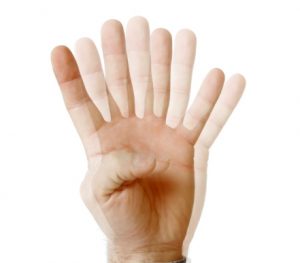
There are three types of diplopia: binocular double vision, monocular double vision and physiological double vision. Binocular double vision is when both eyes do not work properly, but if the patient covers one eye, their vision returns to normal.
Monocular double vision is when a patient covers the unaffected eye and the vision remains doubled. Only one eye produces the double vision, so when the affected eye is covered vision appears normal.
Lastly, physiological double vision is when objects that a person is not focusing on appear double. This type of double vision can go unnoticed because the brain compensates for the double vision in the background. This type of double vision is most commonly seen in children.
What causes double vision?
Depending on the type of double vision you have, there are a variety of causes. Here are the causes of double vision based on each type of diplopia.
- Thyroid disease
- Arterial disease
- Diabetes
- Myasthenia
- Multiple sclerosis
- Aneurysm
- Blood clot
- Stroke
- Cancer
- Injury
Monocular double vision causes
- Abnormality in the cornea
- Abnormality in the iris
- Abnormality in the lens of the eye
- Abnormality in the vitreous humor
- Abnormality in the aqueous humor
Physiological double vision causes
- Astigmatism
- Cataracts
- Dry eye
- Swelling in the eyelid
- Dislocated lens
Double vision can also be temporary. Common causes of temporary double vision include:
- Alcohol consumption
- Concussion
- Anti-epileptic drug side effect
- Anticonvulsant
- Hypnotic drug side effect
- Tiredness
Symptoms of double vision
The main symptom of double vision is seeing two of a singular object. This condition is often confused with blurry vision, but in blurred vision a single object is unclear and in double vision there appears to be two of the same object.
For some, double vision can be temporary and come and go, but for others it can be a daily occurrence.
How to diagnose diplopia?
Your doctor will perform a number of physical examination tests that will identify any potential physical abnormality causing diplopia. However, the most effective tool will be the information you provide during the history portion of the examination. Once the symptoms of double vision have been presented to the doctor, they will most likely ask you a series of related questions that will narrow down the causes. These questions may include:
- When did the double vision start?
- Have you hit your head, fallen, or been unconscious?
- Were you in a car accident?
- Is the double vision worse at the end of the day or when you’re tired?
- Have you had any other symptoms besides double vision?
- Do you tend to tilt your head to one side when looking at objects?
Additional eye related examination tests will then take place to better understand your presenting symptoms. This will often include looking at distance objects, assessing field of vision, and covering one eye while looking at objects.
Double vision treatment
The type of double vision that you have – binocular or monocular – will determine the modes of treatment that can be done. Common treatment options for binocular double vision include:
- Having a contact lens in one eye that blocks vision
- Wearing an eye patch
- Receiving Botox injections to strengthen weak eye muscles
- Wearing glasses with filters
- Eye exercises
- Opaque intraocular lens – removing the lens and replacing it with an implant
Treatment for monocular double vision:
- Treating an astigmatism with corrective lenses
- Laser eye surgery
- Removing cataracts
- Treating dry eye syndrome by using tear substitutes
Although not life-threatening, double vision can be a nuisance and impede on daily life. Understanding the underlining cause is a good start in determining treatment options for double vision. Getting regular eye exams is also beneficial as changes in visions can be spotted immediately, before complications arise.
What are the eye exercises for diplopia?
Pencil push-up therapy: You begin in a seated position with a pencil in hand. Hold the pencil in front of your face at a distance where you are still able to clearly read the letters on the pencil, then slowly move the pencil closer to your nose while maintaining focus on the pencil. Move the pencil away from your nose once the letters on the pencil begin to blur. This exercise is commonly advised for convergence insufficiency.
Swinging: Start by standing up and choosing an object in the distance to stare at. Now gently sway your body from side to side, as the same time keeping the object in focus the best you can. This exercise encourages your eyes to move in ways that are difficult for them.
Eye rolling: Rolling your eyes in both directions may help coordinate eye movements and get your eyes to move inward, downwards, and in every direction. Begin by sitting down and looking straight ahead. Now roll your eyes clockwise in large motions, then counterclockwise, while blinking in-between eye movements.
Prognosis of diplopia
The likely course of having diplopia will ultimately depend on the underlying cause. Double vision in one eye (monocular diplopia) due to blurred vision, however, is seen to have a good prognosis as long as the underlying cause is treatable with options such as glasses or surgical realignment. Variations of the condition involving both eyes may resolve with treatment, but some instances may lead to permanent misalignment of the eyes due to nerve damage or scarring.